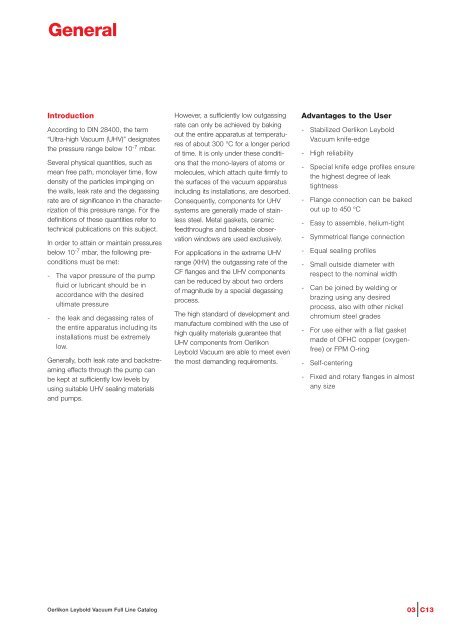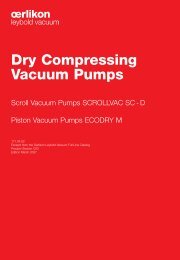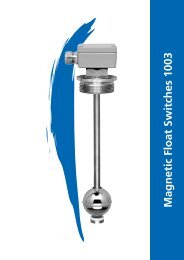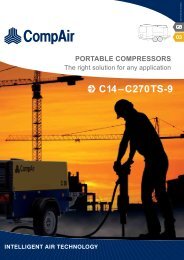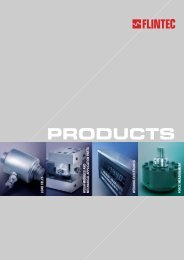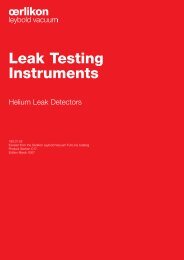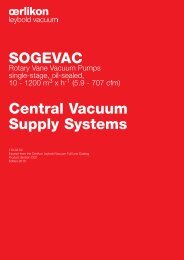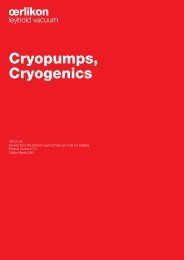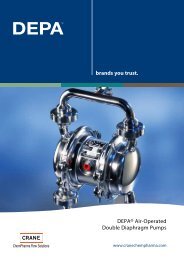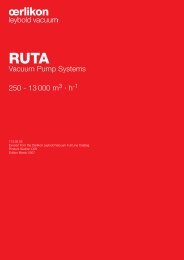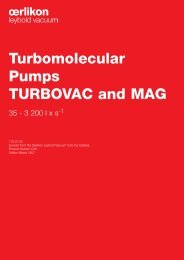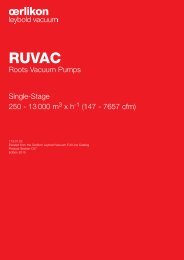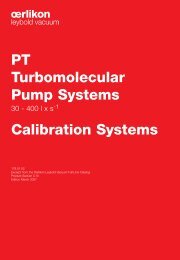Vacuum Fittings Feedthroughs - Granzow
Vacuum Fittings Feedthroughs - Granzow
Vacuum Fittings Feedthroughs - Granzow
You also want an ePaper? Increase the reach of your titles
YUMPU automatically turns print PDFs into web optimized ePapers that Google loves.
General<br />
Introduction<br />
According to DIN 28400, the term<br />
“Ultra-high <strong>Vacuum</strong> (UHV)” designates<br />
the pressure range below 10 -7 mbar.<br />
Several physical quantities, such as<br />
mean free path, monolayer time, flow<br />
density of the particles impinging on<br />
the walls, leak rate and the degassing<br />
rate are of significance in the characterization<br />
of this pressure range. For the<br />
definitions of these quantities refer to<br />
technical publications on this subject.<br />
In order to attain or maintain pressures<br />
below 10 -7 mbar, the following preconditions<br />
must be met:<br />
- The vapor pressure of the pump<br />
fluid or lubricant should be in<br />
accordance with the desired<br />
ultimate pressure<br />
- the leak and degassing rates of<br />
the entire apparatus including its<br />
installations must be extremely<br />
low.<br />
Generally, both leak rate and backstreaming<br />
effects through the pump can<br />
be kept at sufficiently low levels by<br />
using suitable UHV sealing materials<br />
and pumps.<br />
However, a sufficiently low outgassing<br />
rate can only be achieved by baking<br />
out the entire apparatus at temperatures<br />
of about 300 °C for a longer period<br />
of time. It is only under these conditions<br />
that the mono-layers of atoms or<br />
molecules, which attach quite firmly to<br />
the surfaces of the vacuum apparatus<br />
including its installations, are desorbed.<br />
Consequently, components for UHV<br />
systems are generally made of stainless<br />
steel. Metal gaskets, ceramic<br />
feedthroughs and bakeable observation<br />
windows are used exclusively.<br />
For applications in the extreme UHV<br />
range (XHV) the outgassing rate of the<br />
CF flanges and the UHV components<br />
can be reduced by about two orders<br />
of magnitude by a special degassing<br />
process.<br />
The high standard of development and<br />
manufacture combined with the use of<br />
high quality materials guarantee that<br />
UHV components from Oerlikon<br />
Leybold <strong>Vacuum</strong> are able to meet even<br />
the most demanding requirements.<br />
Advantages to the User<br />
- Stabilized Oerlikon Leybold<br />
<strong>Vacuum</strong> knife-edge<br />
- High reliability<br />
- Special knife edge profiles ensure<br />
the highest degree of leak<br />
tightness<br />
- Flange connection can be baked<br />
out up to 450 °C<br />
- Easy to assemble, helium-tight<br />
- Symmetrical flange connection<br />
- Equal sealing profiles<br />
- Small outside diameter with<br />
respect to the nominal width<br />
- Can be joined by welding or<br />
brazing using any desired<br />
process, also with other nickel<br />
chromium steel grades<br />
- For use either with a flat gasket<br />
made of OFHC copper (oxygenfree)<br />
or FPM O-ring<br />
- Self-centering<br />
- Fixed and rotary flanges in almost<br />
any size<br />
Oerlikon Leybold <strong>Vacuum</strong> Full Line Catalog<br />
03 C13


